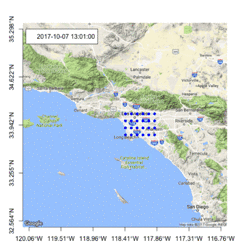
![]()
![]() As a first post to this shiny new website I thought I would show a fun little GIF. This is an example of how we can use 4-D meteorology fields to drive a Lagrangian Particle Dispersion Model (LPDM) in order to forecast transport of a source emission. The particular model used in this simulation is HYSPLIT developed by the folks over at the NOAA Air Resources Laboratory (NOAA ARL). These techniques allow us to work up expected conditions for the emissions before the flight and inform us on whether or not to deploy the aircraft or, if operational constraints allow, wait until we have better meteorology in order to accomplish the measurement goal.
As a first post to this shiny new website I thought I would show a fun little GIF. This is an example of how we can use 4-D meteorology fields to drive a Lagrangian Particle Dispersion Model (LPDM) in order to forecast transport of a source emission. The particular model used in this simulation is HYSPLIT developed by the folks over at the NOAA Air Resources Laboratory (NOAA ARL). These techniques allow us to work up expected conditions for the emissions before the flight and inform us on whether or not to deploy the aircraft or, if operational constraints allow, wait until we have better meteorology in order to accomplish the measurement goal.
Here we are forecasting the transport of a urban emissions from LA. We release particles (imaginary air parcels) into our model and transport them using the previously mentioned LPDM. These simulations were generated as a part of an ongoing sampling campaign with Dr. Paul Shepsons Group at Purdue University. The objective here was to predict whether it would be feasible to
fly down wind of LA and measure a constant plume of the urban emissions with the goal of understanding the various sources of methane.
Enjoy!